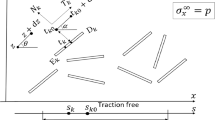Abstract
A solution is presented for the elastic stress intensity factors at the tip of a slightly curved or kinked two-dimensional crack. The solution is accurate to first order in the deviation of the crack surface from a straight line and is carried out by perturbation procedures analogous to those of Banichuk [1] and Goldstein and Salganik [2, 3]. Comparison with exact solutions for circular arc cracks and straight cracks with kinks indicates that the first order solution is numerically accurate for considerable deviations from straightness. The solution is applied to fromulate an equation for the path of crack growth, on the assumption that the path is characterized by pure Mode I conditions (i.e., K II=0) at the advancing tip. This method confirms the dependence of the stability, under Mode I loading, of a straight crack path on the sign of the non-singular stress term, representing tensile stress T acting parallel to the crack, in the Irwin-Williams expansion of the crack tip field. The straight path is shown to be stable under Mode I loading for T<0 and unstable for T>0.
Résumé
On présente une solution pour les facteurs d'intensité de contrainte élastique à l'extrémité d'une fissure bi-dimensionnelle légèrement incurvée ou croquée.
La solution est exacte au premier degré pour la déviation à la surface de la fissure à partir d'une ligne droite, et est mise en oeuvre à l'aide de procédures de perturbations analogues à celles de Banichuck, et de Goldstein et Salganik.
Une comparaison avec les solutions exactes dans le cas de fissures en arc de cercle et de fissures droites avec un croquage indique que la solution du premier ordre est numériquement exacte pour des déviations déjà importantes par rapport à une fissure purement droite.
La solution est appliquée à la formulation d'une équation décrivant le parcours de la croissance d'une fissure, en supposant que ce parcours est caractérisé des conditions de Mode I pures (càd. K h=0) à l'extrémité de la fissure.
Cette méthode confirme la dépendance de la stabilité sous une mise en charge de Mode I d'un parcours d'une fissure droite par rapport aux signes du terme de contrainte non singulière représentant la contrainte de traction agissant parallèlement à la fissure dans un champ de Irwin-Williams décrivant l'expansion à l'extrémité de celle-ci. On montre que le chemin en ligne droite est stable sous une mise en charge de Mode I lorsque T est inférieur à O et instable lorsque T est supérieur à O.
Similar content being viewed by others
References
N.V. Banichuk, “Determination of the Form of a Curvilinear Crack by Small Parameter Technique” Izv. An SSR, MTT 7, 2 (1970) 130–7 (in Russian).
R.V. Goldstein and R.L. Salganik, “Plane Problem of Curvilinear Cracks in an Elastic Solid”, Izv. An SSR, MIT 7, 3 (1970) 69–82 (in Russian).
R.V. Goldstein and R.L. Salganik, International Journal of Fracture 10 (1974) 507–23.
F. Erdogan and G.C. Sih, Journal of Basic Engineering 85 (1963) 519–27.
J.G. Williams and P.D. Ewing, International Journal of Fracture Mechanics 8 (1972) 441–6.
I. Finnie and A. Saich, International Journal of Fracture 9 (1973) RCR 484–6.
P.D. Ewing and J.G. Williams, International Journal of Fracture 10 (1974) RCR 135.
P.D. Ewing, J.L. Swedlow and J.G. Williams, International Journal of Fracture 12 (1976) 85–93.
B. Cotterell, International Journal of Fracture Mechanics 1 (1965) 96–103.
M.C. Hussain, S.L. Pu and J. Underwood, “Strain Energy Release Rate for a Crack Under Combined Mode I and Mode II”, in Fracture Analysis, Proceedings of the 1973 National Symposium on Fracture Mechanics, Part II, ASTM Special Technical Publication 560 (1973) 2–28.
K. Palaniswamy and W.G. Knauss, “On the Problem of Crack Extension in Brittle Solids Under General Loading”, in Mechanics Today, S. Nemat-Nasser, Editor, Vol. 4, Pergamon Press (1978) 87–148.
G.C. Sih, Engineering Fracture Mechanics 5 (1973) 365–77.
G.C. Sih, “A Special Theory of Crack Propagation in Mechanics of Fracture, Methods, Analysis and Solutions of Crack Problems”, Noordhoff (1973).
G.C. Sih, International Journal of Fracture 10 (1974) 305–21.
B.A. Bilby and G.E. Cardew, International Journal of Fracture 11 (1975) RCR 708–12.
B.A. Bilby, G.E. Cardew and I.C. Howard, “Stress Intensity Factors at the Tip of Kinked and Forked Cracks”, in Fracture 1977, Vol. 3, University of Waterloo Press (1977) 197.
V.V. Dudukelanko and N.B. Romalis, Direction of Crack Growth Under Plane Stress State Conditions, Izv. An SSR, MTT 8 1973 129–36.
K.K. Lo, Journal of Applied Mechanics 45 (1978) 797–802.
N.I. Muskhelishvili, “Some Basic Problems on the Mathematical Theory of Elasticity”, Noordhoff (1952).
G.C. Sih, P.C. Paris and F. Erdogan, Journal of Applied Mechanics 29 (1962) 306.
S.N. Chatterjee, International Journal of Solids and Structures 11 (1975) 521–38.
H. Kitagawa and R. Yuuki, “Anlaysis of Branched Cracks Under Biaxial Stresses”, in Fracture 1977, Vol. 3, University of Waterloo Press (1977) 201.
H. Kitagawa, R. Yuuki and T. Ohira, Engineering Fracture Mechanics 7 (1975) 515–29.
V. Vitek, International Journal of Fracture 13 (1977) 481–501.
M.L. Williams, Journal of Applied Mechanics 24 (1957) 109–114.
B.R. Lawn and T.R. Wilshaw, “Fracture of Brittle Solids”, Cambridge University Press (1975).
H.M. Westergaard, Journal of Applied Mechanics 66 (1939) 49.
B. Cotterell, International Journal of Fracture 2 (1966) 526–33.
J.C. Radon, P.S. Lever and L.E. Culver, “Fracture Toughness of Pmma Under Biaxial Stress”, in Fracture 1977, Vol. 3, University of Waterloo Press (1977) 1113–8.
Author information
Authors and Affiliations
Additional information
Research supported by the U.S. National Science Foundation/Materials Research Laboratory at Brown University.
Research supported by the U.S. National Science Foundation/Materials Research Laboratory at Brown University.
Rights and permissions
About this article
Cite this article
Cotterell, B., Rice, J. Slightly curved or kinked cracks. Int J Fract 16, 155–169 (1980). https://doi.org/10.1007/BF00012619
Received:
Revised:
Issue Date:
DOI: https://doi.org/10.1007/BF00012619




